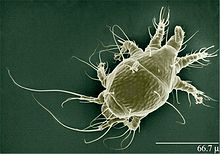
Mites are small arachnids. Mites span two large orders of arachnids, the Acariformes and the Parasitiformes, which were historically grouped together in the subclass Acari. However, most recent genetic analyses do not recover the two as each other's closest relative within Arachnida, rendering the group non-monophyletic. Most mites are tiny, less than 1 mm (0.04 in) in length, and have a simple, unsegmented body plan. The small size of most species makes them easily overlooked; some species live in water, many live in soil as decomposers, others live on plants, sometimes creating galls, while others again are predators or parasites. This last type includes the commercially destructive Varroa parasite of honey bees, as well as scabies mites of humans. Most species are harmless to humans, but a few are associated with allergies or may transmit diseases.

Whiteflies are Hemipterans that typically feed on the undersides of plant leaves. They comprise the family Aleyrodidae, the only family in the superfamily Aleyrodoidea. More than 1550 species have been described.

Tetranychus urticae is a species of plant-feeding mite generally considered to be a pest. It is the most widely known member of the family Tetranychidae or spider mites. Its genome was fully sequenced in 2011, and was the first genome sequence from any chelicerate.

Spider mites are members of the Tetranychidae family, which includes about 1,200 species. They are part of the subclass Acari (mites). Spider mites generally live on the undersides of leaves of plants, where they may spin protective silk webs, and can cause damage by puncturing the plant cells to feed. Spider mites are known to feed on several hundred species of plants.

Gerbera jamesonii is a species of flowering plant in the genus Gerbera belonging to the basal Mutisieae tribe within the large Asteraceae family. It is indigenous to South Eastern Africa and commonly known as the Barberton daisy, the Transvaal daisy, and as Barbertonse madeliefie or Rooigousblom in Afrikaans. It was the first species of Gerbera to be the subject of a scientific description, studied by J. D. Hooker in Curtis's Botanical Magazine in 1889.

Parasitiformes are a superorder of Arachnids, constituting one of the two major groups of mites, alongside Acariformes. Parasitiformes has, at times, been classified at the rank of order or suborder.
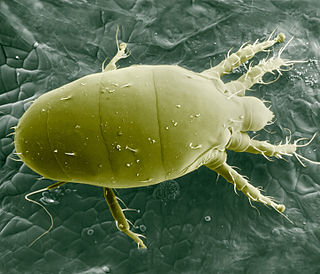
The broad mite, Polyphagotarsonemus latus, is a microscopic species of mite found on many species of plants, spanning 60 families including important agricultural species such as cotton, soybean, blackberries, strawberries, peppers, and other fruits. Broad mites are also currently affecting cannabis plants, as the industry matures with legalization. The mites are found in many areas worldwide and are major greenhouse pests.

Tarsonemus is a genus of trombidiform mites within the family Tarsonemidae.
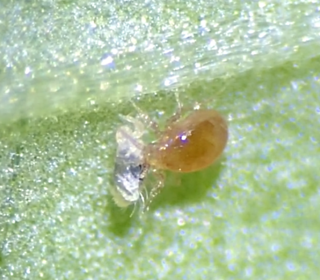
The Phytoseiidae are a family of mites which feed on thrips and other mite species. They are often used as a biological control agent for managing mite pests. Because of their usefulness as biological control agents, interest in Phytoseiidae has steadily increased over the past century. Public awareness of the biological control potential of invertebrates has been growing, though mainly in the US and Europe. In 1950, there were 34 known species. Today, there are 2,731 documented species organized in 90 genera and three subfamilies.
Feltiella acarisuga is a species of predatory gall midges which will feed on various species of spider mites. It is especially common when spider mites occur in colonies. It requires a high spider mite density and high humidities to become established.

Tydeidae is a family of acariform mites. As of 2016, it contained over 300 species in three subfamilies, though more species have been discovered since then.
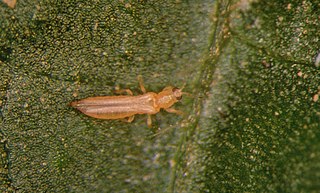
The western flower thrips [Frankliniella occidentalis (Pergande)] is an invasive pest insect in agriculture. This species of thrips is native to the Southwestern United States but has spread to other continents, including Europe, Australia, and South America via transport of infested plant material.

The Prostigmata is a suborder of mites belonging to the order Trombidiformes, which contains the "sucking" members of the "true mites" (Acariformes).

Steneotarsonemus spinki, the panicle rice mite, spinki mite, or rice tarsonemid mite, is a species of mite in the family Tarsonemidae, the white mites. It is a serious pest of rice in tropical Asia, Central America, and the Caribbean.
Neoseiulus californicus is a predatory mite that feeds on Tetranychid mites. This species was first described on lemons from California under the name Typhlodromus californicus in 1954.

Neoseiulus cucumeris, the cucumeris mite, is a species of predatory mite in the family Phytoseiidae. It is used in biological pest control of western flower thrips in cucumber and some other greenhouse crops.
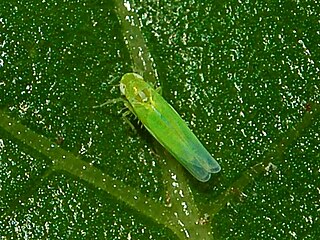
Empoasca decipiens is a species of leafhopper belonging to the family Cicadellidae subfamily Typhlocybinae. The adults reach 3–4 millimetres (0.12–0.16 in) of length and a are homogenously green with whitish markings on its pronotum and vertex. E. decipiens is commonly referred to as the “green leafhopper” because of its colouration. The absence of clear stripes along the forewings can easily distinguish it from the similar leafhopper species E. vitis, but distinguishing it from other leafhoppers with the same colouration requires examination under a microscope. It is present in most of Europe, in the eastern Palearctic realm, in North Africa, in the Near East, and in the Afrotropical realm. Both nymphs and adults of this small insect are considered to be a very destructive pests on field crops, vegetables and greenhouse plants.
Typhlodromips swirskii, the Swirski mite, is a species of predatory mite in the family Phytoseiidae. It is used in biological pest control of western flower thrips in greenhouse or indoor grown crops.

Stigmaeidae is a family of prostigmatan mites in the order Trombidiformes. At over 600 species, it is the largest family in superfamily Raphignathoidea. It has a worldwide distribution.

Oligonychus pratensis, the Banks grass mite, is a species of mite in the spider mite family. They are considered a pest and often infest corn and turf grasses.
